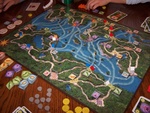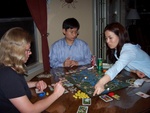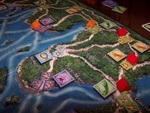
|
Amazonas A game by Stefan Dorra Published by Mayfair Games, Inc. and Kosmos Players: 3-4 Time: 45-60 minutes Reviewed by Susan Rozmiarek |

|
Components:
- Game board that unfolds to be approximately 22 by 17 inches.
- 48 wooden Research Stations, 12 of each of the four player colors
- 60 Specimen Tokens, 12 each of five different types
- 4 Native Tokens
- 28 Income Cards, in sets of 7, one for each player
- 18 Event Cards
- 3 Secret Mission Cards
- 4 Turn Order Cards
- 16 small, wooden, grey discs, representing Silver Coins
- 28 larger, wooden, yellow discs, representing Gold Coins
- 4 Bonus Tokens
- 4-page color Rulebook
Game play & Commentary:
In Amazonas, players take on the role of researchers exploring the Amazon rain forest and collecting wildlife specimens.
The board depicts a map of the region dotted with villages connected by a series of water and jungle pathways.
Each turn, players will collect income and have the opportunity to build research stations in these
villages in order to collect sets of specimens for victory points at the end of the game.
They will find themselves hindered by such dangers as jaguars, crocodiles, and forest fires in the form of event cards.
Summary of a round of play:
- Draw an event card
- Play Income Cards and determine order of play
- In player order, players each take a turn collecting their income and building Research Stations
Next, each player secretly chooses an Income Card and then all are simultaneously revealed. Players all have the same basic set of seven cards, each depicting a number from zero to six, and one of each the five specimen types, except for the "6" card, which depicts a Native, and the "0" card which shows all the specimen types. Each player will receive income for his turn in silver coins equal to the number depicted plus one for each specimen tile he has collected of the type depicted on his card. With the "0" card he collects silver coins for the specimen type of which he has the most. The "6" card is special. It depicts a Native and gives an extra silver coin for each Native Token a player has. (See below for an explanation about natives). However, its real power is that when it is played, the player is allowed to ignore any negative event in effect for this round. The positive events are not affected. For this reason, it is important for players to keep track of which events might be coming up and to save their "6" card for the potentially nasty ones.
Players will not get their cards back until they have used them all, after seven rounds, at which time they pick them all up to be used again. This mechanism has been used in many games by different designers, including in Dorra's earlier design, Yucata. It is also in a much earlier Alex Randolph game, Raj, and in a recent game, Niagara by Thomas Liesching. It works well, putting all players on the same footing, although some people may be tired of it. It works well in Amazonas.
After determining income, players now all get a building turn, starting with the player getting the most income this round, followed by the player with the second most, and so on. There are Turn Order Cards to pass out each round to keep track of the order, but we found them unnecessary. Ties are broken by a small white number at the top of the Income Cards. These numbers are the only difference in the players' sets of Income Cards. This actually gives certain players a slight edge, but I really haven't noticed it being a real factor in our games. If it bothers you, there is a fix for it on www.boardgamegeek.com.
Each village shows the costs in gold coins for building a Research Station there, as well as the type of specimen that can be collected. Each village can only hold a limited number of Research Stations and the cost for subsequent players to build goes up. There is often a race to get to the cheapest, 2-gold villages, as well as villages in key locations. Players are limited in where they can build, however. New Research Stations must be connected to one of their previously built stations via a water or jungle path. When a player builds a station, he pays the cost in gold, places one of his Wooden Huts on the village and takes a Specimen Token from the general supply of the type depicted on that village. Players keep their collections of Specimen Tokens open in front of them.
It needs to be noted that three silver coins equals one gold coin. Players get their income in silver coins, but the cost for new stations is in gold coins. Money is very tight in this game. Players may build as many Research Stations on their turn as they are able, but it is rare to be able to build more than one, especially in the beginning half of the game.
There are a few things to note about the board. There are a couple of key villages, Rosaria and Santa Caņo that are centrally located. These villages are also part of a chain of inexpensive villages in a rather isolated corner of a board. A player who is allowed to build first in these villages without competition will have a significant advantage. This is not a problem once players become familiar with the game, but there can be a runaway leader if new players are not aware of this.
There is a deck of 18 Event Cards, one for each round. The game will end after 18 rounds, which will allow each player to go through his set of Income Cards one-and-a-half times. This is an important fact to remember and keep track of.
As previously mentioned, each round, an Event Card is turned over and in effect for that round only. The following events are in the deck:
- Jaguar (2): Players cannot use jungle paths to get to new villages to build stations.
- Crocodile (2): Like the jaguar, except now players cannot use water paths.
- Forest Fire (3): Each player gets only half his income rounded down this round.
- Theft (2): After each player gets his income from the round, a monkey steals silver coins from each player equal to the number of specimen tokens in his highest set. You only have to pay what you have, if you don't have enough. This is a good time to play an Income Card which doesn't get you much income to begin with.
- Bonus Research Money (5, one for each specimen type): This gives each player one additional silver coin for each token he has of the specimen type depicted on the Event Card. This money is NOT counted for starting player determination.
- Natives (4): When this card comes into effect, a Native Token is placed on the card. The starting player may take the Native Token instead of his income for that round. If he chooses to take it, he assigns it to one of his specimen types and it now acts as one of those specimens for income determination and for scoring at the end of the game. If he chooses his income instead of the Native, the next player gets the same choice.
Important point: The Native Token must be assigned to a specimen type that a player has already collected. This point is vague in the rules, but has since been clarified by the folks at Mayfair. Natives are more powerful the earlier they are acquired, as they give extra income for both the specimen they represent and when a "6" card is played.
There are two other nice features in the game that drive the game play:
Bonus points for Specimen Tokens: The first player to get all five specimen types gets a bonus of five points, the second player to do so, four points, the third, 3 points, and the fourth, 2 points. This makes for a tougher decision as to what specimens to pursue, since sets of the same specimen will score at the end of the game.
Secret Mission Cards: At the beginning of the game, each player will get a Secret Mission Card (all different) that depicts four villages. Each village on the card that he does not build by the end of the game will be a minus three victory points. Of course, these villages are spread out over the board, making it more difficult to achieve. This mechanism encourages players to spread out in their building instead of concentrating in one region of the board, making it likely that they will be running into each other and competing for locations. There are only eight of these Secret Mission Cards, and some have criticized the game, saying that after repeated play, players will know these cards well enough to figure out where other players are trying to go. I have not found this to be a factor at all in our games, but I suppose it could with very cutthroat players.
End Game Scoring: After the 18th Event Card has been drawn and that round completed, the game ends. Victory points for collected sets of like specimens are now awarded to each player. In order for a set to score points, it must have at least three or more of the same type of specimen. Each specimen in the set then scores one point. Sets with two or fewer specimens score nothing. A player add up points for each set of three or more, plus points for a Bonus Token, if collected, and then subtracts three points for any village on his Secret Mission Card that he was unable to build in. The player with the highest total of victory points wins the game. The designer of the game has an alternate way to score that is posted at www.boardgamegeek.com. It supposedly makes the game meatier, but I haven't tried it.
Summary:
This game has quite a few things going for it.
It falls into that lower middleweight category that is so good for family play or introducing new people to designer games.
The rules are simple, the presentation is gorgeous and it has just right amount of light strategic planning without feeling overwhelming.
It usually plays in under an hour. At first blush, it seems to be wholly tactical,
but stick with it and play it a couple of times and the strategies will start to emerge.
The decisions aren't particularly tough, but they are a fun exercise.
Amazonas is not without its faults; there is a slight imbalance with the player cards for ties, and the board has some characteristics that can make first plays frustrating. Playing with only three players is less exciting than with four, as there is less competition for spots on the board, an important requirement for tension in the game. These are rather minor quibbles, however, and if you enjoy games such as Ticket to Ride and Around the World in 80 Days, you are likely to enjoy Amazonas as well.
| Other Web information: |
This page viewed
 times since July 8, 2005.
times since July 8, 2005.
E-mail Ed Rozmiarek with questions or problems concerning this page.
Copyright © 2005, Ed & Susan Rozmiarek. No portion of this website may be reproduced or copied without the consent of Ed or Susan Rozmiarek.




